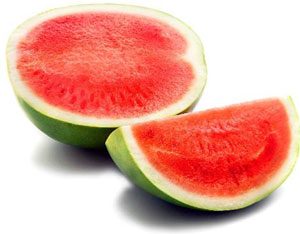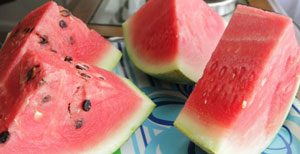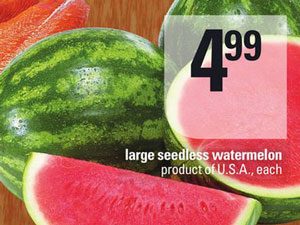Description
Botanical Name: Citrullus lanatus
Seedless watermelon’s are simply watermelon variety that do not contain the usual large black seeds. It is important not to be confused by the name given to these species because technically they are not seedless. Seedless watermelons still contain small soft easily edible white seeds. These watermelons posses all the same features of ordinary watermelons minus the added black seeds:
- Oblong or round in shape
- Between 6 to 25 pounds in weight
- Hard/firm green outer skin
- Red, yellow or orange flesh
- Sweet in taste
- Available throughout the year although grow best in the summer
- Comprised of 90% water
- Contain the same vitamins as seeded varieties: A, B and C
- Contain potassium and iron
- Can be prepared the same way: raw, seared or grilled

Difference Between Seeded and Seedless Varieties
Although they share many similar features as the seeded variety of watermelon, seedless watermelons are infertile (unable to reproduce itself) due to the way in which they have been genetically formed using two plants that have incompatible chromosomes. This means that each individual seedless watermelon must ironically be grown from their own individual seed. This process can be timely and costly for the farmer which reflects on the purchase price of a seedless watermelon. Seedless watermelons are known as hybrids (something derived by combining two different elements) due to the way they are produced. Many people believe that seedless watermelons have been genetically modified but this is not the case. Read ‘The Truth About Seedless Watermelons’.

Seeded watermelon on the left & seedless watermelon on the right
How to Grow Seedless Watermelons
It is a complex process that takes place when farming seedless watermelons due to their infertility. Seedless watermelons are known as a triploid because instead of having twenty two chromosomes like the seeded variety they have thirty three chromosomes.
The process that takes place to create a thirty three chromosome seedless watermelon is as followed:
- A chemical process takes place (the adding of colchicine) to double the number of chromosomes so that twenty two becomes forty four
- This is then known as a tetraploid
- The pollen of the diploid (22 chromosome watermelon) is then put into the female flower of a tetraploid (44 chromosome watermelon)
- This then creates a seed that contains thirty three chromosomes- a seedless watermelon
As you can see this process is complex and is best taken out by a scientist. Not only are these seeds complex to create but when sowing these seeds they also need to be placed in soil at a minimum of 70 degrees Fahrenheit (21 degrees Celsius) and have a greater success rate when grown in a greenhouse.

Cost associated with seedless watermelons.
Facts About Seedless Watermelon
- Seedless watermelons have only been produced since 1939
- The first specimen of a seedless watermelon was created by a Japanese scientist at Kyoto University
- Half of the watermelons grown in California are seedless varieties
- A seedless watermelon seed costs between twenty to thirty cents each which gives an insight to why the end result, a seedless watermelon is more expensive than its relative the seeded watermelon
Just had our first Seedless watermelon of the season. I was telling my wife, I thought seeded melons tasted better, and she says it’s all in my head…..So to prove her wrong I read all of your watermelon articles, and dang it she was right, I miss the big black seeds when I eat it!
Hello where can I get Chris Kent watermelon seeds I’m Staying in Africa
Creating a triploid is a genetic manipulation! How the genes are expressed in a triploid is also probably different than in a diploid.